24 Hours Hotline: +86 137-3541-1378
Email:suzhou@tripstoshanghai.com
24 Hours Hotline: +86 137-3541-1378
Email:suzhou@tripstoshanghai.com
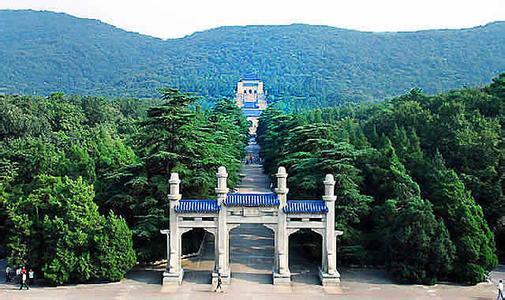
Dr. Sun Yat-sen's Mausoleum, Nanjing
Brief Introduction
The mausoleum of Dr. Sun Yat-sen (1866-1925), the father of the Republic of China, is a site of deep historical significance, magnificent architecture and beautiful scenery located at the Zhongshan Scenic Area in Purple Mountain. Covering nearly 20 acres, the lush scenic is a tribute to the noble spirit and heroic efforts of Dr. Sun Yat-sen's devotion to the Chinese people and their fight for independence. Visitors can view the memorial archway, mausoleum gate, tombstone pavilion and memorial hall. The coffin chamber is not accessible to visitors.
Highlights
Dr. Sun Yat-sen's Mausoleum is situated at the southern foot of Zhongshan Mountain. Lying on the lower portion of the mountain, it looks out into the plain comprised of an elongated passage way immersed in the lush surroundings. Covering an area of over 133 hectares, the mausoleum was designed by Lu Yanzhi, an outstanding Chinese architect who was concurrently the architect of the tomb. The construction of the mausoleum started in 1926, and Dr. Sun Yat-sen's coffin was subsequently moved there in the of 1929 from Beijing.
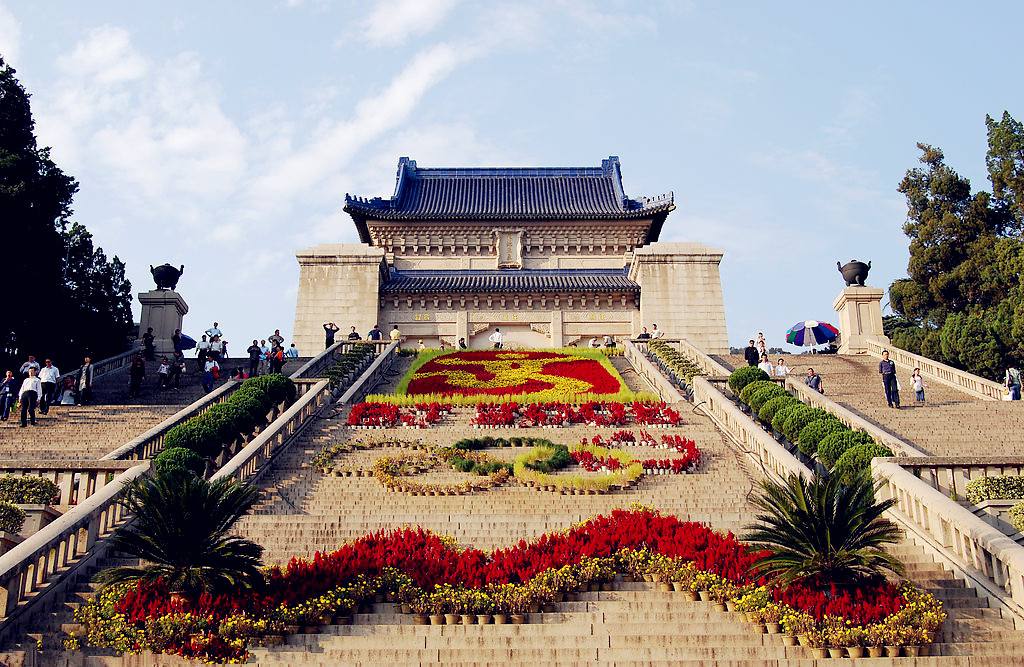
Entrance to the mausoleum of Dr. Sun Yat-Sen is free because the Chinese government wants its people to go visit the sites that celebrate the political revolution of 1912. Although this site is a point of pride for China, there's an interesting dichotomy at play because of Sun Yat-Sen’s affiliation with the political practices that now play out in Taiwan rather than mainland China. Traveling along the marble road towards the mausoleum, you will first arrive at the half-moon square south of the mausoleum. Then at the entrance to the mausoleum you will see the great marble memorial archway. Through it extends the Passway of 480 meters long and 40 meters wide. Situated on the Passway is the Frontispiece combining three archway gates encased in copper. Four Chinese characters written by Dr. Sun Yat-sen are inscribed on the doorways that translates to "The World Belongs to All", which signifies the cause he struggled for during his life.
Passing through the Pavilion, you will next come across the sacrificial hall and in the center of it, you will find a big statue of Dr. Sun Yat-sen with a firm and sincere look on his face. Caressing an open book on his lap, he seems to be contemplating the present and future states of China. Surrounding the statue are sculptures demonstrating the revolutionary leaps that the giant had taken during his life. The texts etched on the walls reminded the visitors of his famous writings that embodied his political and philosophical ideologies.
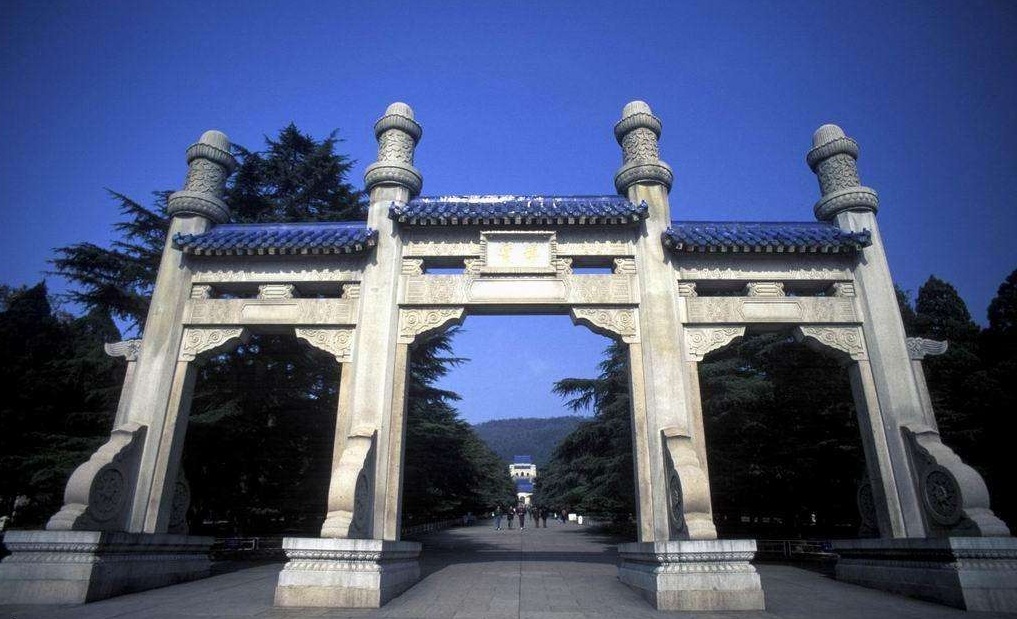
The forever resting place of Dr. Sun Yat-sen is in the circular coffin chamber north of the sacrificial hall. This tranquil area marks the remains of this great revolutionary and leader.
Dr. Sun Yat-sen
Sun Yat-sen was a Chinese physician, writer, philosopher, calligrapher and revolutionary, the first president and founding father of the Republic of China. As the foremost pioneer of the Republic of China, Sun is referred to as the "Father of the Nation" in the Republic of China (ROC), Hong Kong, Macau and the "forerunner of democratic revolution" in People's Republic of China (PRC). Sun played an instrumental role in the overthrow of the Qing dynasty during the years leading up to the Xinhai Revolution. He was appointed to serve as Provisional President of the Republic of China when it was founded in 1912. He later co-founded the Nationalist Party of China, serving as its first leader. Sun was a uniting figure in post-Imperial China, and he remains unique among 20th-century Chinese politicians for being widely revered amongst the people from both sides of the Taiwan Strait.
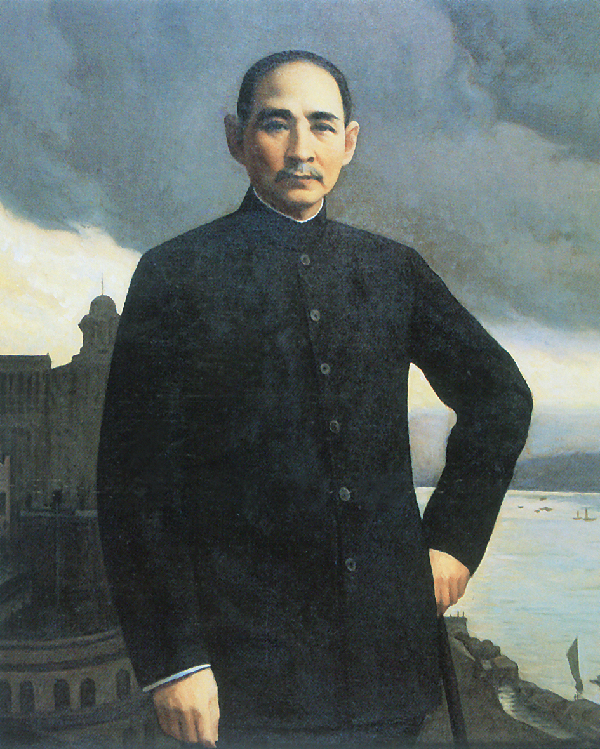
Although Sun is considered to be one of the greatest leaders of modern China, his political life was one of constant struggle and frequent exile. After the success of the revolution, he quickly resigned from his post as President of the newly founded Republic of China due to Beiyang Clique pressure, and led successive revolutionary governments as a challenge to the warlords who controlled much of the nation. Sun did not live to see his party consolidate its power over the country during the Northern Expedition. His party, which formed a fragile alliance with the Communists, split into two factions after his death.
Sun's chief legacy resides in his developing of the political philosophy known as the Three Principles of the People: nationalism (non-ethnic, independence from imperialist domination), democracy, and the people's livelihood.
Selection of the design
A committee decided to host a design competition in order to collect designs for the Sun Yat-sen Mausoleum. The committee put advertisements in the newspapers on 5 May, 1925, inviting architects and designers at home and abroad to send their designs. In exchange for a 10 yuan charge, the committee would provide the designer with 12 pictures of the site. The design would have to adhere to guidelines. It had to be done in a traditional Chinese style that also evoked a modern design with special and memorial substance. Not only should it evoke the Chinese architectural spirit, but also add creativity. Designers were required to insure that the proposed construction costs within 300,000 yuan (the final cost exceeded 3,000,000 Yuan). Over 40 proposals were received. On 20 September, 1925, the committee convened in Shanghai, and unanimously selected Lu Yanzhi's proposal.
The mausoleum was designed by Lu Yanzhi and completed by Poy Gum Lee between 1926–1929.
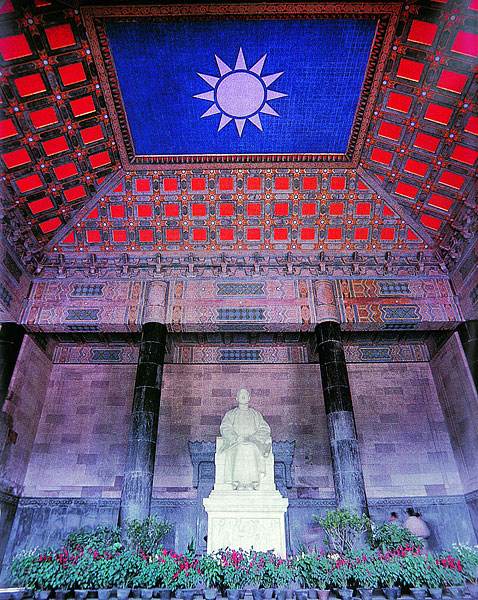
Architecture
Reclining on a mountain slope, the majestic mausoleum blends the styles of traditional imperial tombs and modern architecture. Lying at the mountainside, the vault is more than 700 meters away from the paifang on the square below, which is the entrance of the mausoleum. There is a three-tier stone stand on which a huge bronze ding, an ancient Chinese vessel symbolizing power, perches. To the north of the square, the paifang towers high. Beyond is the 480-meter-long and 50-meter-wide stairway which has 392 stairs leading to the vault. On both sides, pine, cypress, and ginkgo trees guard the way. At the end of the stairway is a gate which is 16 meters high and 27 meters wide. The tri-arched marble gate is inscribed with the personal motto of Dr. Sun, with four Chinese characters written by him, "Tian Xia Wei Gong", which means "What is under heaven is for all". Inside the gate, there is a pavilion in which a 9-meter-high stele is set, which is a memorial monument set by the Kuomintang (KMT). A few stairs up is the sacrificial hall and the vault.
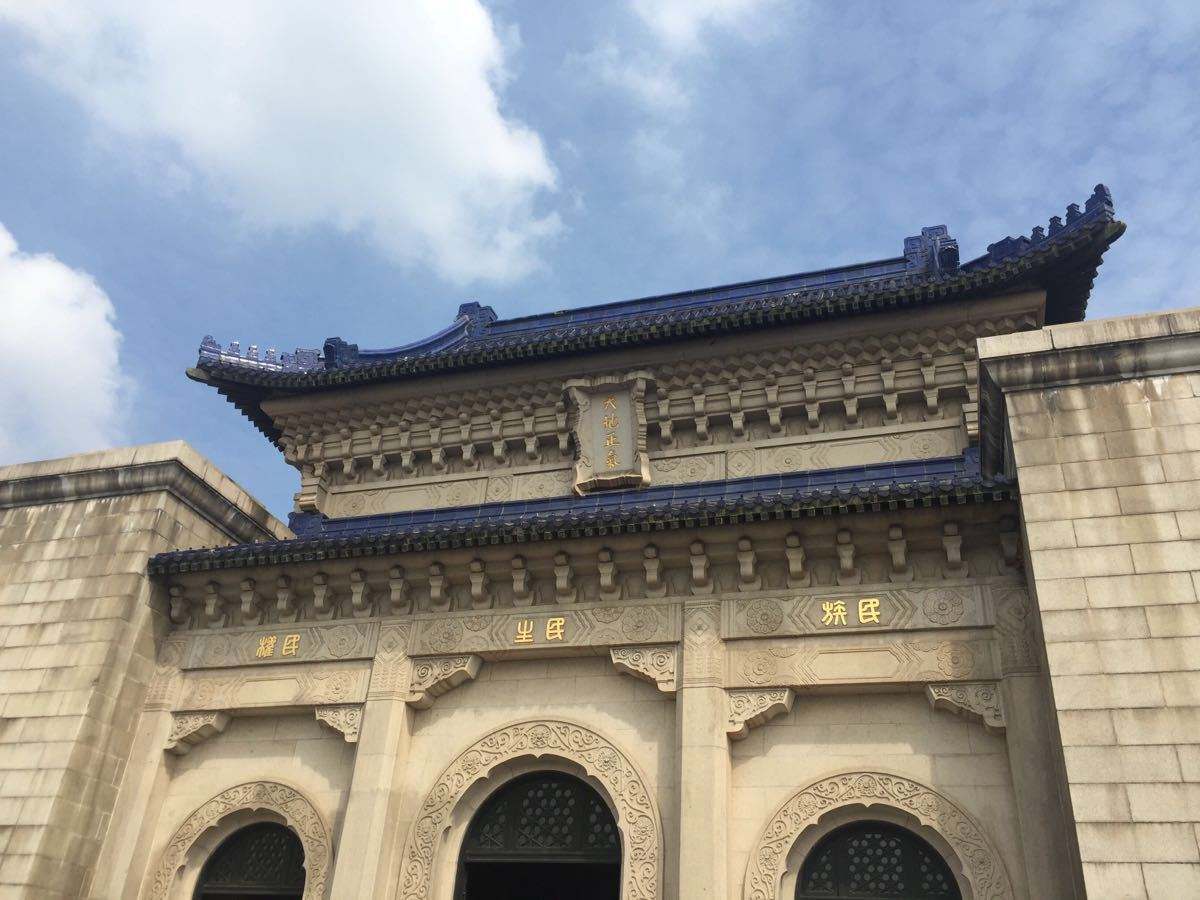
In front of the sacrificial hall there stands a pair of huabiao, ancient Chinese ornamental columns, which are 12.6 meters high. The sacrificial hall is actually a palace of 30 meters in length, 25 meters in width and 29 meters in height. In the center of the hall a 4.6-meter-high statue of Dr. Sun sits. The statue was sculptured out of Italian white marble. The hall's ceiling features the flag of the Kuomintang. Biographical information on Dr. Sun is available to visitors in the hall. North of the hall lies the bell-shaped vault, wherein lies the sarcophagus of Dr. Sun.
Architectural influence of the Mausoleum's design is evident in Taiwan's Chiang Kai-shek Memorial Hall.
How to get Dr. Sun Yat Sen Mausoleum
Bus Routes: Take bus No. 1, 2, 3, 5, 9, 20
Taxi: All cab drivers know the address
Travel Guide
Admission Fee: CNY 25
Hours: 8:30 a.m.–5 p.m. (Closed Monday)
Time for visit: 3 Hours
Tel: 025-4431991 4446111-2157
Most Popular Nanjing Tours including Sun Yat Sen Mausoleum
1. Authentic Nanjing Day Tour From Suzhou/Shanghai by Bullet Train
2. 2-Day Private Nanjing Highlights Tour
3. Nanjing History and Culture Experience Tour
4. Ultimate Nanjing Tour Packages From Shanghai
5. 5-Day Shanghai Suzhou Nanjing Highlight Tour by Bullet Train
If you want to see more Nanjing tours including Sun Yat Sen Mausoleum, please refer to Nanjing Private Tours.
Duration:6-8 Hours
Attractions(Cities):Nanjing Massacre Museum, Presidential Palace, Yuejianglou Tower, Confucius Temple
Tour Style:This one-day Nanjing private tour offers a perfect blend of history, culture, and scenic beauty. Your day begins at Sun Yat-Sen’s Mausoleum, nestled against the stunning backdrop of Purple Mountain, where you’ll learn about the legacy of modern China’s founding father. Next, visit the Ming Xiaoling Mausoleum, the burial site of the first Ming emperor, famous for its grand architecture and tranquil surroundings. In the afternoon, head to the Confucius Temple, a serene cultural site set along the lively Qinhuai River, where you can immerse yourself in both the spiritual significance and local charm of Nanjing’s historic heart. Finally, explore the Nanjing Ming City Wall, a well-preserved fortress offering panoramic views of the city. This thoughtfully crafted itinerary offers a comprehensive look at Nanjing’s iconic landmarks, combining rich history with scenic landscapes for an enriching and memorable experience.
Duration:10+ Hours
Attractions(Cities):Sun Yet-Sen Mausoleum, Ming Xiaoling Mausoleum, Zhonghua Gate, Confucius Temple
Tour Style:This Nanjing Day Tour from Shanghai offers a deep dive into the history and culture of the Ming Dynasty. Visit must-see landmarks such as the ancient City Wall, the impressive Ming Xiaoling Mausoleum, the formidable Zhonghua Gate, the vast Nanjing Museum, and the serene Confucius Temple. Each site offers unique insights into Nanjing’s rich historical and cultural heritage. With personalized service and expert guidance, this tour ensures a seamless and enriching experience, allowing you to explore Nanjing’s rich heritage at your own pace while learning about the city’s pivotal role in Chinese history. Enjoy comfortable transportation and ample time to absorb the beauty and significance of each landmark, making for a memorable and immersive day in one of China’s most historic cities. This expertly designed itinerary combines cultural immersion, historical exploration, and local flavor, ensuring a comprehensive and fulfilling experience for every traveler.
Duration:6-8 Hours
Attractions(Cities):Linggu Temple, Qixia Temple, Jiming Temple
Tour Style:This Nanjing 1 day tour is thoughtfully crafted for travelers seeking a deep, soulful experience that blends Buddhist spirituality with the tranquility of nature. Ideal for those interested in cultural immersion, spiritual reflection, and scenic beauty, the tour brings you to Nanjing’s most revered temples—Linggu Temple, Qixia Temple, and Jiming Temple—each with its own unique atmosphere and historical legacy. Gentle forest walks on Purple Mountain and around Qixia Valley provide moments of serenity and scenic wonder, while a wholesome vegetarian lunch adds a mindful, nourishing touch to your journey. Led by an insightful English-speaking guide, this tour offers not only historical knowledge, but also emotional connection and cultural depth. Whether you’re a solo traveler, a couple, or a group of spiritually curious explorers, this full-day escape promises peace, inspiration, and a deeper understanding of Chinese Buddhism and nature-based philosophy.
Duration:6-8 hours
Attractions(Cities):Niushoushan, Zhonghuamen Gate, The Confucius Temple
Tour Style:This private Nanjing day tour blends spiritual discovery with historical exploration, offering a balanced journey through the tranquil Buddhist temples of Niushoushan, the formidable Ming-era architecture of Zhonghua Gate, and the vibrant cultural atmosphere of Confucius Temple. At Niushoushan, you’ll uncover the deep-rooted Buddhist traditions and admire the magnificent Usnisa Palace, a masterpiece of religious architecture. Then, step back in time at Zhonghua Gate, the largest surviving ancient city gate complex in China, where military strategy and craftsmanship meet. Finally, soak in the lively charm of the Confucius Temple area, with its riverside views, traditional streets, and enduring legacy of Confucian thought. Ideal for travelers seeking cultural depth, peaceful scenery, and architectural wonders, this one-day experience combines sacred spaces, ancient city walls, and historic ambiance—all with the comfort of a personal guide, private vehicle, and local insights that bring Nanjing's rich heritage to life.
Duration:6-8 Hours
Attractions(Cities):Sun Yet-Sen Mausoleum, Presidential Palace, Lingu Temple, Confucious Temple
Tour Style:Make the most of your time to get a unique travel experience in Nanjing on a full-day Nanjing tour. Served as the capital city of ancient China, Nanjing is endowed with profound history and cultural sites. With your knowledgeable and historical guide, you'll visit the majestic Sun Yat-Sen Mausoleum, marvel at the Presidential Palace, explore the peaceful Lingu Temple, and follow in the paths of emperors on a relaxing Qinhuai River cruise near the Confucius Temple. This tour combines rich history, stunning architecture, and beautiful natural surroundings, offering you an immersive experience of Nanjing's culture and heritage. It is a perfect private-designed tour to lead you through Nanjing's timeless landmarks with comfortable city transfer, ensuring a smooth and unforgettable journey.
Wechat: Chinaprivatetour
24 Hours Hotline:
+86 137-3541-1378
(Your Privacy is Protected)
1 to 1 tailor-made service from our professional travel advisors for the most sophisticated
Constantly excellent reviews for attraction, hotel and service Competitive price
Local experts provide quality tours Best selected knowledgeable local guides Authentic local restaurants
7*24 hours available to create you a worry-free tour. No Hidden Fees and absolutely no pressure to buy. Secured









Copyright © 2017 Suzhouprivatetour.com All rights reserved. 浙ICP备18056007号-4